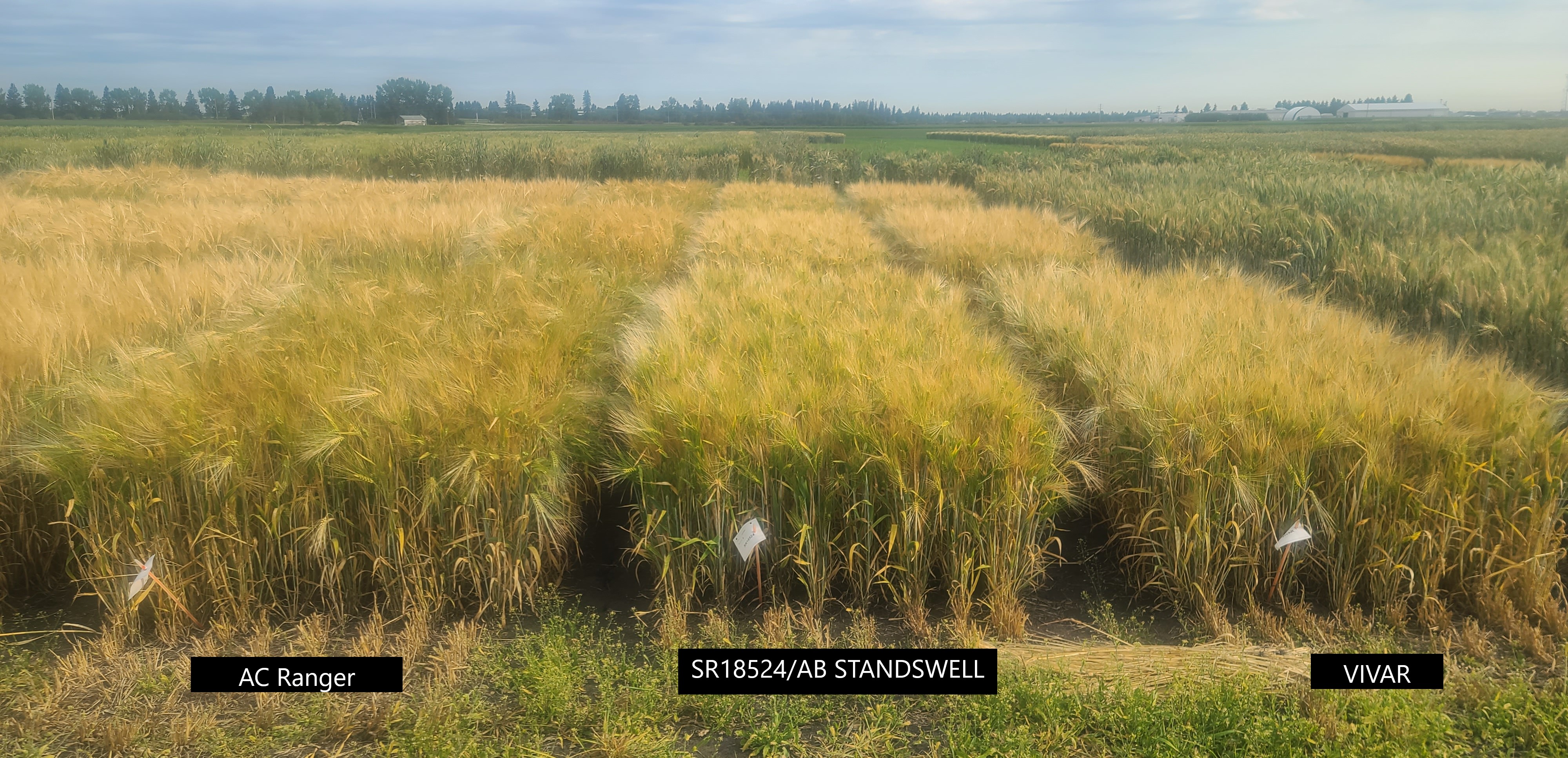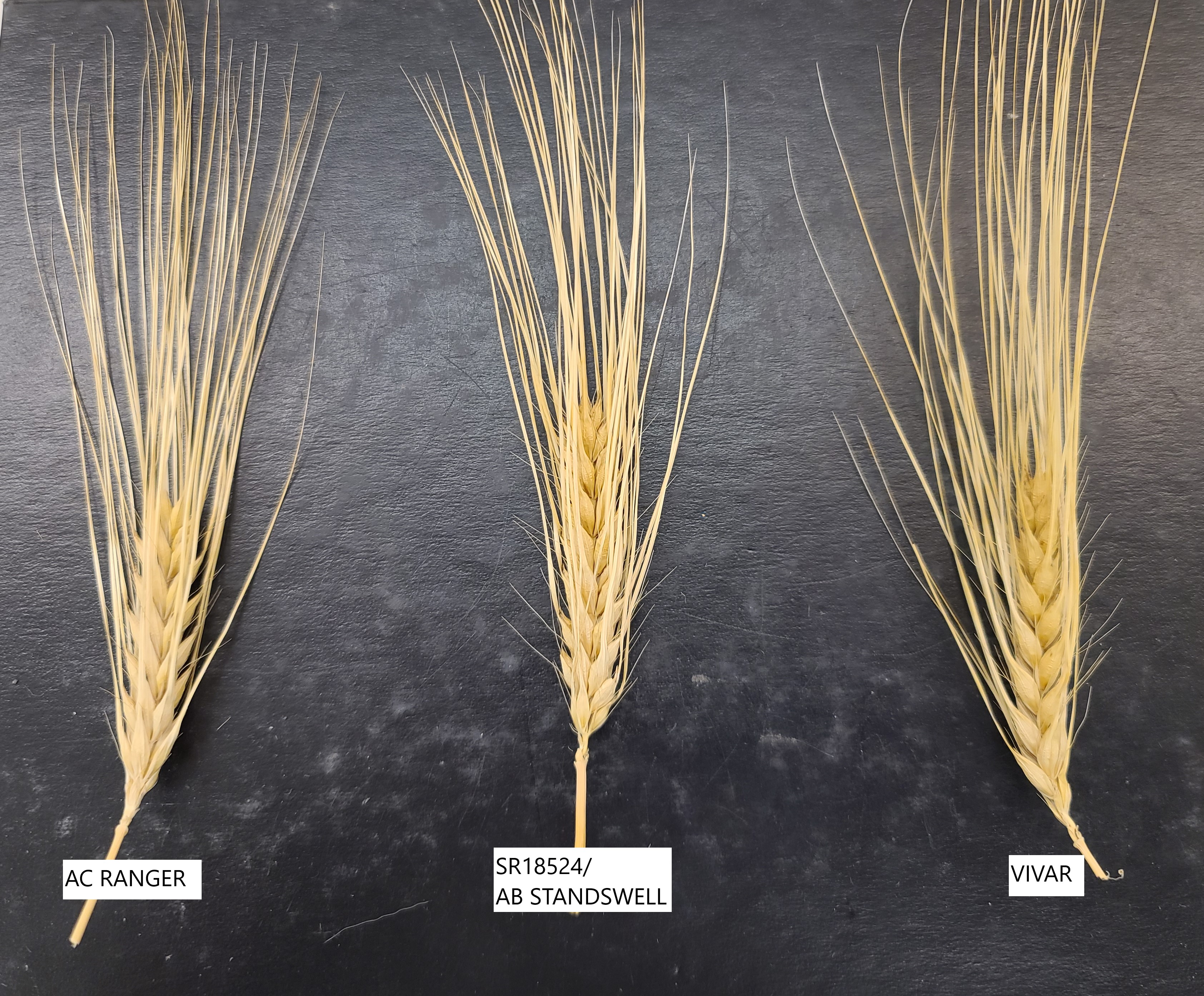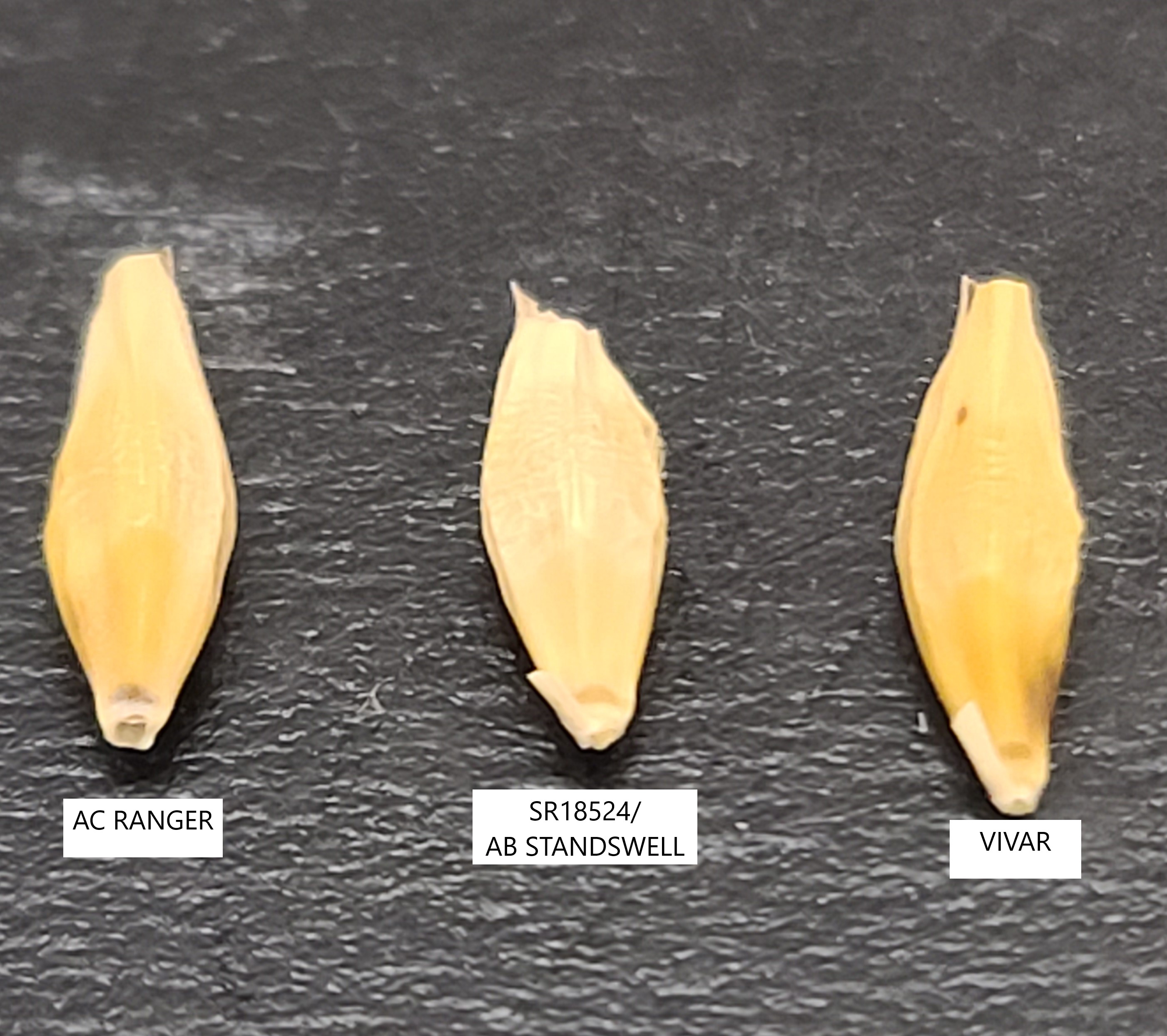AB Standswell
| Denomination: | 'AB Standswell' |
|---|---|
| Botanical Name: | Hordeum vulgare |
| Applicant/Holder: |
Alberta Agriculture and Irrigation Crop Assurance and Rural Programming Branch 1st Floor, 7000-113 Street Edmonton, Alberta T6H 5T6 Canada |
| Breeder: |
Yadeta Kabeta, Alberta Agriculture and Forestry, Lacombe, Alberta |
| Agent in Canada: |
Olds College -Field Crop Development Centre 5030 - 50th Street Lacombe, Alberta T4L-1W8 Canada Tel: 403-391-8617 |
| Application Date: | 2022-05-25 |
| Provisional Protection:: | 2022-05-25 |
| Application Number: | 22-10932 |
Variety Description
Varieties used for comparison: 'AC Ranger' and 'Vivar'
Summary: At the 5 to 9 tiller stage, the plants of 'AB Standswell' have a semi-erect growth habit while those of 'AC Ranger' and 'Vivar' have an intermediate growth habit. The lower leaf sheath of 'AB Standswell' has sparse pubescence while that of 'AC Ranger' has absent or very sparse pubescence. At booting, the flag leaf of 'AB Standswell' is wider than that of 'Vivar'. At the beginning of anthesis, the lemma awn tips of 'AB Standswell' have a weak intensity of anthocyanin colouration while those of 'Vivar' have an absent or very weak intensity of anthocyanin colouration. At the end of anthesis, the spike of 'AB Standswell' has a semi-erect attitude while that of 'AC Ranger' has a horizontal attitude. At the beginning of ripening, the plants of 'AB Standswell' are shorter than the plants of 'AC Ranger'. The spike of 'AB Standswell' is lax while that of 'Vivar' is of a medium density. At maturity, the first segment of the rachis of 'AB Standswell' is long with a strong curvature while those of the reference varieties are of a medium length with a weak curvature. The rachilla hairs on the kernel of 'AB Standswell' are long while those of the reference varieties are short. Hairs are absent on the ventral furrow of the kernel of 'AB Standswell' while hair is present on the ventral furrow on the kernels of the reference varieties.
Description:
YOUNG PLANT: semi-erect growth habit at tillering, sparse pubescence on lower leaf sheaths
PLANT: two row, spring feed barley, low frequency of plants with recurved flag leaves
FLAG LEAF (AT BOOTING): sparse pubescence on blade
FLAG LEAF SHEATH: medium glaucosity, sparse pubescence
AURICLES: very weak intensity of anthocyanin colouration at booting, sparse pubescence on margins
SPIKE: mid-season emergence, weak glaucosity at end of anthesis, semi-erect attitude, platform shaped collar, tapering shape, lax, glume and its awn of the median spikelet are longer than the grain
LEMMA AWNS: weak intensity of anthocyanin colouration of tips at beginning of anthesis, longer than spike length, rough spiculations on margins
FIRST SEGMENT OF RACHIS: long, strong curvature
KERNEL: strong intensity of anthocyanin colouration of nerves of the lemma at early to soft dough stage, long rachilla hairs, husk present, weak spiculation of inner lateral nerves of dorsal side of lemma, hairless ventral furrow, clasping disposition of lodicules, incomplete horseshoe shaped basal markings, medium length and width
Origin & Breeding History: 'AB Standswell' (experimental designations T09156061, FB 492 and SR18524) was developed using a single seed descent breeding method. The variety originated from a cross between an experimental line designated 109505 and the variety 'Vivar' conducted in 2009 at the Field Crop and Development Centre in Lacombe, Alberta. The variety was advanced from the F1 to F4 generation based on grain and forage yield, lodging resistance, maturity, test and kernel weight with one line being designated as T09156061 in 2011. The variety was further evaluated as T09156061 from 2014 to 2017 in Alberta and as SR18524 and FB 492 across Western Canada from 2018 to 2019. Breeder seed was established at the F11 generation in 2019.
Tests & Trials: The comparative trials for 'AB Standswell' were conducted at the Olds College Field Crop and Development Centre in Lacombe, Alberta in the 2022 and 2023 growing seasons. There were 3 replicates per variety per year. Plots consisted of 8 rows, each row measuring 2.5 metres long with 0.14 metres inter-row spacing. The seeding density of 269 seeds per square metre resulted in approximately 2175 plants per variety per year. Measured characteristics were based on a minimum of 30 measurements per variety per year. Mean differences were significant at the 5% probability level based on a paired Student`s t-test.
Comparison tables for 'AB Standswell' with reference varieties 'AC Ranger' and 'Vivar'
Flag leaf width (at booting) (mm)
| 'AB Standswell' | 'AC Ranger' | 'Vivar' | |
|---|---|---|---|
| mean (2022) | 17.0 | 14.0 | 7.0 |
| std. deviation (2022) | 1.08 | 1.63 | 2.88 |
| mean (2023) | 10.0 | 10.0 | 9.0 |
| std. deviation (2023) | 1.77 | 1.50 | 1.60 |
Plant height (stem plus spike, including awns) (cm)
| 'AB Standswell' | 'AC Ranger' | 'Vivar' | |
|---|---|---|---|
| mean (2022) | 102.0 | 114.0 | 103.0 |
| std. deviation (2022) | 6.60 | 7.18 | 5.75 |
| mean (2023) | 63.0 | 72.0 | 64.0 |
| std. deviation (2023) | 4.27 | 5.36 | 3.80 |
Click on image for larger view

Barley: 'AB Standswell' (centre) with reference varieties 'AC Ranger' (left) and 'Vivar' (right)
Click on image for larger view

Barley: 'AB Standswell' (centre) with reference varieties 'AC Ranger' (left) and 'Vivar' (right)
Click on image for larger view

Barley: 'AB Standswell' (centre) with reference varieties 'AC Ranger' (left) and 'Vivar' (right)
- Date modified: